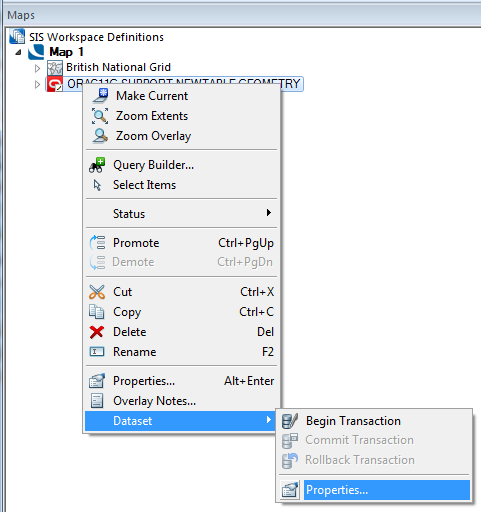
Database transactions can be used with overlays created using the database cursor datasets where the overlay has a status of editable (this will mean it is in dynamic mode). Transactions allow users to edit the data in the overlay without others users being able to view the changes, until the current user decides to make the edits permanent.
Transaction capabilities are available for all the RDBMS cursor datasets (Oracle, Microsoft SQLServer and PostGIS). To start a transaction right-click on the database overlay in the Maps Control Bar and select Dataset > Properties...

The Cursor Dataset Details dialog will be displayed:

Click on Begin to start a transaction. Click Finish. Begin editing the data.
After the edits are finished redisplay the Cursor Dataset Details dialog and you will two active options:
Rollback
This will release the transaction and allow other users to obtain editable access to the data. The changes you made will not be applied to the dataset.
Note: Regenerating an overlay whilst in the middle of a transaction causes the transaction to rollback. In addition all undo information for the overlay will be cleared.
Commit
This will commit the changes permanently to the database and release the transaction. All users will now be able to view the data.
Alternatively, the three Transaction commands; Begin, Commit and Rollback may also be accessed locally as shown below:
Only allow editing inside a Transaction
Check this tickbox to ensure no edits can be made outside of the current transaction.
Note: This tickbox can be checked by the GIS Manager to provide an extra layer of protection against any inadvertent changes being made outside the current transaction.
Other users who are connected to the same data source will be locked out when an item is edited during a database transaction. Users will be locked out until a Commit or Rollback are issued against the original transaction.
Whilst locked out no function in SIS will be available.
Before starting a transaction you should should confirm your intended action with the GIS Manager who will be in a position to know whether the map area being edited is due to be edited by any other user.
Cadcorp recommend the following points are observed:
For example:
If user A has started a transaction and has edited feature 1 and user B selects the same feature in another session. SIS allows the feature to be selected but if an attempt is made to edit the feature SIS will appear to hang. The SIS session will hang until user A either commits or rolls back the transaction. This is default database behaviour and similar behaviour can be reproduced using Oracle and SQL Plus.
Send comments on this topic.
Click to return to www.cadcorp.com
© Copyright 2000-2017 Computer Aided Development Corporation Limited (Cadcorp).